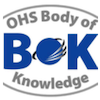Chapter 24: Ionising Radiation
Abstract
Despite increased use of radiation in the workplace since the 19th century, the topic is associated with fear and lack of understanding in the community. While the level of natural background radiation makes it difficult to assess the impact of exposure to work-related radiation, the damage to the body is dose-related and cumulative, often with a long latency period. Thus the hazards and level of risk should be identified and managed. There is a legislative requirement for users of radiation sources to be licensed and for suitably trained responsible persons to be appointed; consequently, this chapter provides a broad overview
of radiation hazards relevant to the generalist OHS professional. Excluding research and medical applications as specialist areas, OHS professionals are most likely to encounter radiation sources in industries such as construction, mining and manufacturing. This chapter reviews the physics of radiation and how ionising radiation can cause damage to the body. It outlines dose limits and risk assessment for radiation hazards, and cites relevant legislation and standards. Principles of radiation protection – justification, limitation and optimisation – are combined with exposure-limiting factors – time, distance and shielding – to develop a hierarchy of control. Finally, implications for OHS practice are discussed.
Keywords: ionising radiation, dose, ALARA
First year of publication: 2012
Current Version: 2021
Chapter 24: Ionising Radiation
Table of contents
| 1 | Introduction |
| 1.1 | Definitions |
| 2 | Historical context |
| 3 | Extent of the problem |
| 4 | Understanding radiation |
| 4.1 | The physics of radiation |
| 4.2 | Types of electromagnetic ionising radiation |
| 4.3 | The impact of ionising radiation on the body |
| 4.4 | Radiation dose and dose limits |
| 4.5 | Risk assessment for radiation exposures |
| 5 | Legislation and standards |
| 5.1 | OHS legislation |
| 5.2 | Radiation legislation |
| 6 | Control |
| 6.1 | Principles of radiation protection |
| 6.2 | Control of exposure |
| 7 | Implications for OHS practice |
| 8 | Summary |
| Key resources | |
| References |
Purchase the AUDIO chapter here through AIHS
OR

Martin I. Ralph BSc(Hons), GC(OHRS), CRadP, MAIHS
Regional Inspector of Mines, at the Mines Safety Directorate of the (WA) Department of Mines, Industry Regulation and Safety (DMIRS).
Martin began his occupational health and safety career in industrial hygiene, specialising in radiation
protection. His past positions have included Managing Director of IFAP, and the Western Australia
Department of Minerals and Energy Special Inspector of Mines (Radiation and Ventilation). Martin is a
member of the Society for Radiological Protection and a certified Radiation Protection Professional. He
has extensive management, OHS and radiation protection experience, and a particular interest in the
psychology of safety, environmental toxicology and public policy in relation to the mining and milling of
radioactive ores
Peer reviewers
Dr David Bromich, Associate Professor and Adjunct, Griffith University
Dr Marcus Cattani, Senior Lecturer, Edith Cowan University
Dr Steven Hinkley, Associate Professor of Physics, Edith Cowan University
Learning Outcomes: Physical Hazards: Ionising Radiation
The OHS Body of Knowledge takes a conceptual approach which enables it to be applied in different contexts and frameworks.
To optimise its value for education and professional development learning outcomes have been developed for each technical chapter in the Body of Knowledge.
The learning outcomes as described give an indication of what should be the capabilities of an OHS professional; it is up to those developing OHS education programs, OHS professionals planning their CPD or recruiters or employers selecting or developing people for the OHS function to consider the required breadth vs. depth .
Please read the section on using the learning outcomes before delving into the leaning outcomes of the individual chapters.
The numbers against each learning outcome refer to the chapter number of the BOK download page. No learning outcomes have been developed for the chapters considered introductory or underpinning knowledge (that is chapters 1, 2, 3, 4, 5, 6, 7, 1, .13, 14, 15.)
Podcast
3M Science of Safety Podcast: Ep 81 Ionising radiation
Ionising radiation is the energy produced from natural or artificial sources in the form of waves or particles. It has enough power to change the composition of substances it interacts with by breaking their chemical bonds. Although radiation has many useful applications in industry and medicine, over-exposure can be detrimental.
Date: 2020
Presenter: Robert Blackley
Source: https://3mscienceofsafety.libsyn.com/episode-81-ionising-radiation
Archived Chapter – 2012 – Chapter 24 Ionising Radiation

